HP HPE0-Y53 Building HPE SDN and FlexNetwork Solutions Online Training
HP HPE0-Y53 Online Training
The questions for HPE0-Y53 were last updated at Dec 10,2025.
- Exam Code: HPE0-Y53
- Exam Name: Building HPE SDN and FlexNetwork Solutions
- Certification Provider: HP
- Latest update: Dec 10,2025
An OpenFlow controller controls several switches that operate in pure OpenFlow mode.
Based on this scenario, what is the controller required to do?
- A . Configure a table miss entry with the Normal action for each switch.
- B . Configure flow entries to handle any loops in the topology.
- C . Use either OpenFlow 1.0 or OpenFlow 1.3, but not both versions.
- D . Ensure that each switch uses a single OpenFlow table.
A company has deployed the HP Network Protector SDN Application solution. The network administrator wants to use this application to prevent clients from accessing specific devices on the private network, including other clients.
Which HP Network Protector feature should the administrator use to configure this policy?
- A . ACL Manager
- B . blacklists
- C . greylists
- D . Redirection server
Refer to the exhibit.
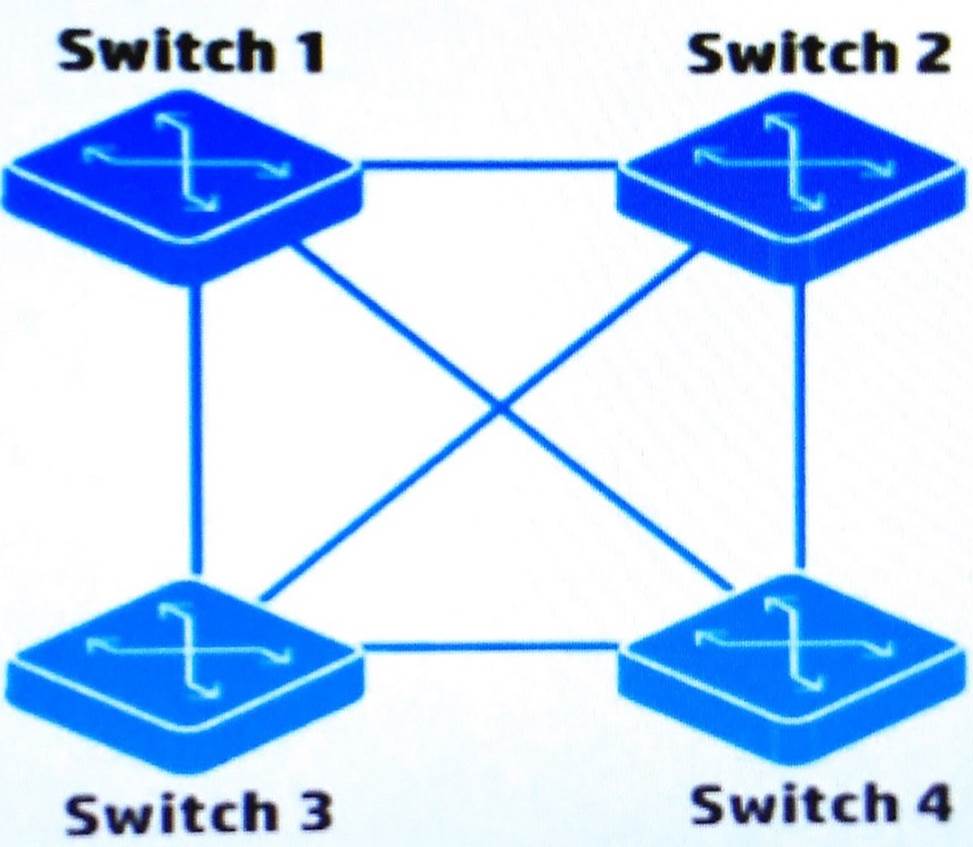
The switches shown in the exhibit use the HP VAN SDN Controller as the OpenFlow controller. They connect to the controller on their out-of-band management (OOBM) ports, but these connections are not shown in the exhibit. The switches also run spanning tree protocol.
An SDN supplication installed on the HP VAN SDN Controller is programmed to discover live ports, find redundant paths, and create loopfree paths for traffic for the infrastructure shown in the exhibit.
However, the application is not able to complete these functions because the switches are reporting some ports as blocked.
What should the network administrator do to let the application create the loopfree paths?
- A . Disable spanning tree on the OpenFlow-enabledswitches and do not configure link aggregation.
- B . Enable spanning tree on the OpenFlow-enabled switches but set the application as the spanning tree flood parameter controller.
- C . Enable spanning tree on the OpenFlow-enabled switches and configure all of the redundant links as egress-only-ports.
- D . Disable spanning tree on the OpenFlow-enabled switches and configure the redundant links as static link aggregations.
Which HP IMC module helps companies to manage TRILL and SPBM solutions, as well as converged LAN/SAN solutions?
- A . HP VAN Resource Manager
- B . HP VAN SDN Manager
- C . HP VAN Fabric Manager
- D . HP VAN Connection Manager
Refer to the exhibit.
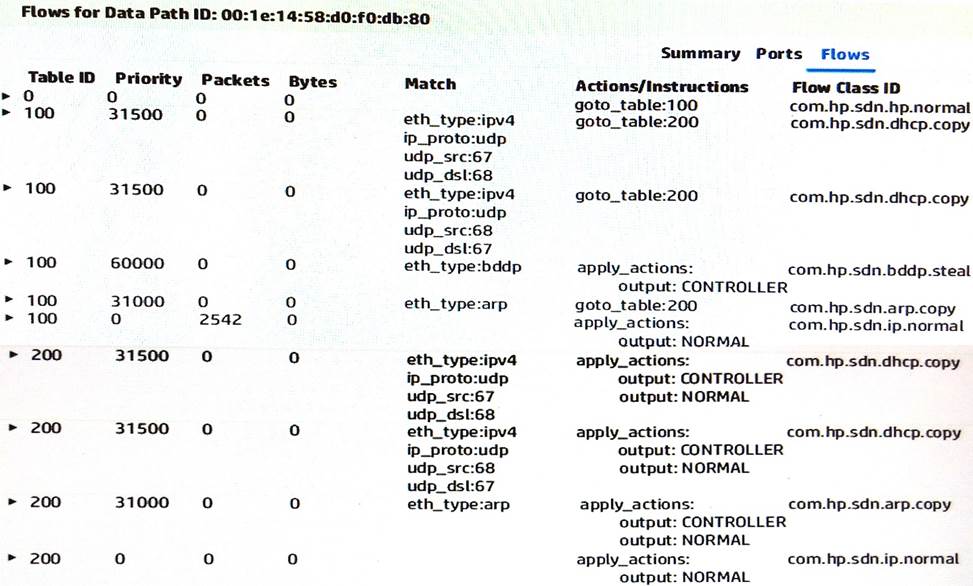
A standard ARP packet arrives on the switch with the flows shown in the exhibit.
How does the switch handle the packet? (Select two.)
- A . It encapsulates the packet and sends it to the controller.
- B . It forwards the packet normally.
- C . It drops the packet.
- D . It transmits the packet on port 200.
- E . It transmits the packet on the ports in group table 200.
An HP ProVision switch supports VLANs 1, 10, 20, and 30. A network administrator wants to create an OpenFlow instance on the switch. This instance should only apply to VLAN 10. The switch reaches the HP VAN SDN Controller in VLAN 20.
How should the administrator begin to set up the instance?
- A . as a named instance with member VLAN 20
- B . as an aggregate instance that excludes VLAN 1 and 30
- C . as a named instance with member VLAN 10
- D . as an aggregate instance that excludes VLAN 1, 20, and 30
Refer to the exhibits.
Exhibit 1
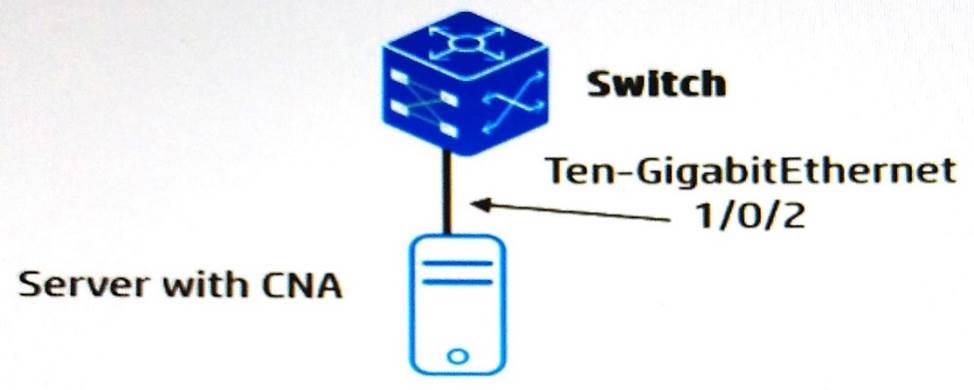
Exhibit 2
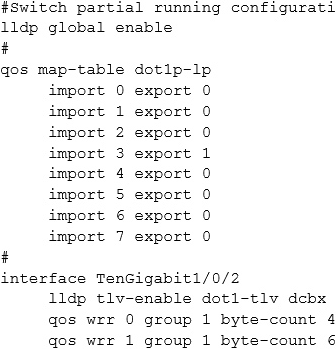
The server and the switch are forwarding traffic on the Ethernet link shown in the exhibit.
How do the server and switch handle traffic with 802.1p value 3?
- A . The switch provides 40 percent of bandwidth for this traffic. The server uses its local configuration to determine how to prioritize this traffic.
- B . Both the server and the switch provide 40 percent of bandwidth for this traffic.
- C . The switch provides 60 percent of bandwidth for this traffic. The server uses its local configuration to determine how to prioritize this traffic.
- D . Both the server and the switch provide 60 percent of bandwidth for this traffic.
A company is deploying the HP Network Visualizer SDN Application. The HP switches already have the correct OpenFlow settings for the HP VAN SDN Controller to control them.
How should the network administrator further configure the HP switches to work with this application?
- A . Configure the OpenFlow VLANs as remote traffic mirror source.
- B . Configure the HP VAN SDN Controller as a remote traffic mirror destination.
- C . Configure SNMP settings that match those on the application.
- D . Configure SSH settings that match those on the application.
Refer to the exhibit.
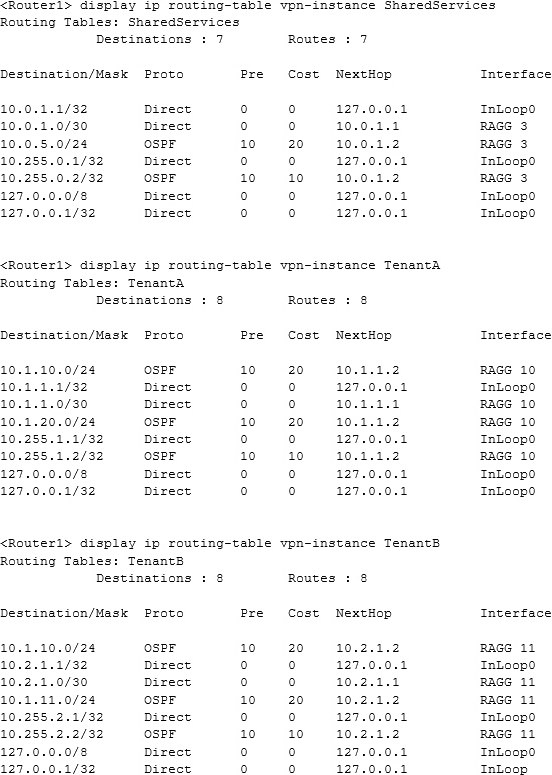
A network administrator wants to route all external traffic from VPN instances “TenantA” and “TenantB” to a firewall at 10.0.5.5 in VPN instance “SharedServices.”
In addition to setting up the routes between the instances, what is another requirement for this scenario?
- A . The RAGG 3 interface must be added to VPN instances “TenantA” and “TenantB.”
- B . A router must implement Network Address Translation (NAT) to translate overlapping tenant network addresses.
- C . Route leaking must be enabled globally on Router1, as well as on each of the VPN instances.
- D . The routes must be redistributed between the different VPN instances.
What is a benefit of using the HP Network Visualizer SDN application for capturing traffic on HP ProVision switches?
- A . This application can correlate captured traffic with user information based on information synced with Microsoft Active Directory.
- B . This application can configure mirroring on switches that do not support OpenFlow using traditional methods, eliminating the needs for upgrades.
- C . This application can forward the captured traffic to HP DVLabs for deeper inspection as to whether the traffic poses a threat to the network.
- D . This application can integrate with VMware vCenter, which uses the captured traffic to determine the correct policies to deploy to virtual hosts.
Latest HPE0-Y53 Dumps Valid Version with 105 Q&As
Latest And Valid Q&A | Instant Download | Once Fail, Full Refund

